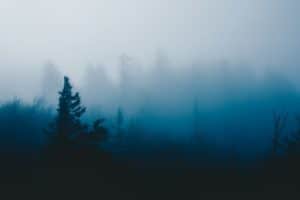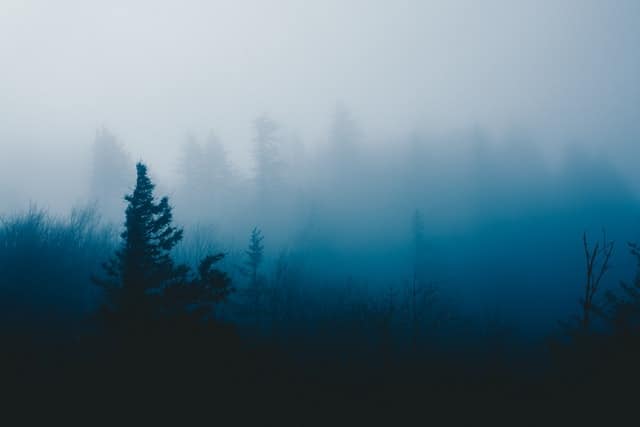 Maybe it’s the way the sunlight shines brighter but fades faster during the daytime. Maybe it’s the way the nights begin to unfurl ever deeper, darker, and longer. Maybe it’s the sharpening edge of chill in the air. But every autumn, without fail, I develop a hankering for some great horror content.
Maybe it’s the way the sunlight shines brighter but fades faster during the daytime. Maybe it’s the way the nights begin to unfurl ever deeper, darker, and longer. Maybe it’s the sharpening edge of chill in the air. But every autumn, without fail, I develop a hankering for some great horror content.
When it comes to horror, I’m not a fan of gore, torture, or content that relies on a pure “ick” factor. Rather, I prefer my horror cerebral, weird, deeply unsettling, and beautifully composed. My favorite horror stories tend to blur genre lines; they’re difficult to categorize as one thing or the other, shifting in and out of science fiction or fantasy, mystery or suspense. They often haunt me long after I close the book or turn off the film. And they always have an extremely strong sense of place. For these reasons, I refer to these stories as “atmospheric horror.”
Have I managed to pique your interest? Good—because I have plenty of recommendations!
If you like a fantasy backdrop, Naomi Novik’s stand-alone novel, Uprooted, tells the tale of a kingdom threatened by a corrupted forest. The Wood, as it is called, crouches in the background of this book like a baleful creature—luring in the unsuspecting, manipulating and calculating its next moves, and operating like a character unto itself. Suffice to say that this book contains one of the most haunting sequences of horror I’ve encountered in a story, when several characters make a valiant but foolish attempt to strike at the heart of the Wood.
Another book that takes place in a corrupted wilderness is Annihilation by Jeff VanderMeer. The story, which is science fiction rather than fantasy, reads like a fever dream in the best way possible. The narrative follows a small group of scientists investigating the mysterious “Area X,” which has variously swallowed, psychologically destroyed, sickened, or otherwise destroyed each of the prior researchers that have attempted to untangle its secrets. Once I cracked it open, I genuinely could not stop reading it until I had finished it; so make sure to clear out your schedule before you pick this one up.
If you need or prefer a short, fast read, I would recommend Scribe by Alyson Hagy, Ghost Wall by Sarah Moss, or In the House in the Dark of the Woods by Laird Hunt. The first two are both under 150 pages, and the last is 225 pages. Scribe is a fable-like, near-future meditation on life after some unnamed societal collapse. Ghost Wall tells the story of reenactors in Britain who, trying to replicate as accurate a historical experience as possible, up to and including discussions of sacrifice, begin to take things a little too far. In the House in the Dark of the Woods is reminiscent, in mood and tone, of the animated show Over the Garden Wall, a modern fairy tale where the main characters journey through a dark forest, meeting grim challenges along the way.
If you’re looking for something closer to reality, Sarah Schmidt’s historical novel, See What I Have Done, reimagines the story of Fall River’s very own Lizzie Borden. Schmidt zooms in on the household in a way that both emphasizes and exacerbates a feeling of overwhelming claustrophobia. By contrast, The Paper Wasp by Lauren Acampora, is set in the modern day and examines how the edges of reality can fray as a mentally unstable woman tries to renew an old high school friendship with a Hollywood star. More recently, Zakiya Dalila Harris’ The Other Black Girl has earned comparisons to Jordan Peele’s 2017 hit film, Get Out. I won’t say too much, for fear of spoiling the narrative, but the novel—like the film—examines the creeping dread and existential horror inherent in living within white supremacist systems as a Black person.
If you prefer nonfiction, don’t worry—there is horror out there for you too. Try Michelle McNamara’s phenomenal I’ll Be Gone in the Dark, chronicling the author’s deep dive into the then-unsolved Golden State Killer case. Descriptions of the killer’s activities will ensure you’ll check your closets and keep your lights on while you read. Alternately, a different kind of horror is described in In the Dream House by Carmen Maria Machado. This memoir details, in searingly lyrical style, how the author lived through and eventually escaped an emotionally abusive relationship.
Finally, if you’re looking for a movie to occupy an evening this autumn, options abound. Rosemary’s Baby (2000) and The Wicker Man (2006) are both classic tales about characters who are thrust into increasingly troubling situations among groups that might or might not be cults. For a slightly updated take on a similar set-up, consider Martha Marcy May Marlene (2012), in which a young woman attempts to re-assimilate into normal life after fleeing from a dangerous cult. If period films are more your speed, 2016’s The Witch can’t be beat—the cinematography and costuming are beautiful, and a sense of creeping dread permeates the entire experience of the movie. Finally, last year delivered two powerhouse horror/suspense films in The Lighthouse and Parasite. Despite their extremely different settings, each of these movies tackles the question of what the dual pressures of isolation and desperation will wreak on a human psyche.
Huddle up under a blanket, don’t answer that knock on your door, and keep the lights on—horror season is here.
Hilary Umbreit (they/them) is the Adult Services Librarian at the Morrill Memorial Library in Norwood, MA. Look for their article in the October 14, 2021 issue of the Transcript and Bulletin.




